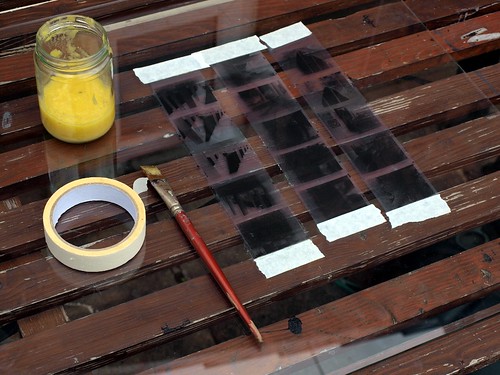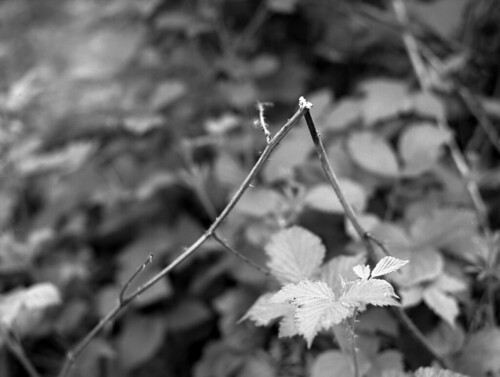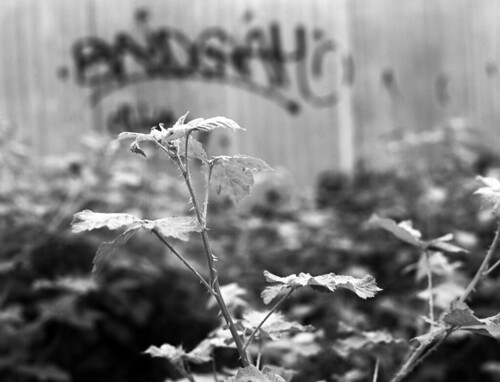I have talked about distressing negatives using bleach (hypochlorite) and also with wire wool already in this blog. Here is an alternative method that promises better control than either: pineapple.
Actually papaya would probably work as well. Both these fruits contain an enzyme that rather slowly dissolves gelatine. Gelatine of course is that jelly-stuff made from boiling skins and bones of animals, and is in fact the stuff that the business-end of a piece of film - the emulsion, that carries the actual image - is made from.
Apologies to vegetarians: film photography is not vegetarian. Non-animal products were tried at some point but obviously were not good enough. In the distant days of photography 100 years ago or more, albumen from eggs was used as an alternative, but that isn't vegan. I am reminded of the story of some very precious waif-like model who turns up at a photo-shoot with her nose in the air, prattling on about how important it is to be kind to animals. When she hears the photographer is using film she complains about the cruelty involved in making film, and refuses to have her photo taken, storming off in a huff. She doesn't even stay long enough to take her coat off (which is very expensive, made from real fur).
Anyway, and back to topic. Pineapple on film. It should work equally well with colour or black and white, slide or print film. I never heard anyone else try this, so it's all very experimental. Try it your own way, but use my suggestions or experience here as a guide if it helps. Here is what I did today.
I got a small very ripe pineapple and took about a quarter. (I eat the rest!) I turned the flesh to pulp in a liquidiser. I taped some negatives emulsion side up to a sheet of glass (any flat surface will do) and got a very soft flat brush.

Now the idea is to brush the pineapple onto the film so that only a very small amount of the emulsion layer comes away, and you can put textures in the image. With the film I had, I discovered leaving pulped pineapple on the film for about 30 minutes removed a bit more than half of the emulsion. Some emulsions are thicker than others, so you may get a different effect. You know when something is really happening fast when the pineapple starts to go a greenish black from the silver in the film. (This is for black and white film. Colour film will behave differently.)
This was the best technique I found. I dolloped pineapple onto the negatives very thickly and spread it round, left it for 5 minutes to let it start working. Then I brushed the emulsion very gently to remove almost all the juice. At this stage the negatives dried quite quickly and the emulsion was soft. I brushed in alternate directions with a brush dipped into a small amount of pineapple, and left it to nearly dry each time. I did this for perhaps 5-10 minutes. Then I washed very carefully and thoroughly, without touching the emulsion.
This is a negative as scanned before the treatment

and the same negative afterwards:

The effect is only just noticeable on the negative looking by it by eye, but of course it is very obvious in the final picture. If you click the image you should be able to go to a larger version. It looks much better up close.
Here is another, first before

and after

To finish with some thoughts and suggestions for more experiments: the interesting thing is the texture that is now on the emulsion. You can try anything at all make a texture when the emulsion is soft. My brush was just a start. I also wonder if the resulting emulsion can be dyed, and some image made because the other different densities from the thickness of the emulsion and the dye. There are also some chemicals that can inhibit the effect of the enzyme, and if you are chemically minded you can look into that and see if you can get them to do anything interesting.
Colour film will behave quite differently as it is made from several layers corresponding to the various colours. This is definitely one to try some time.
Finally, some warnings. Pineapple juice is of course safe, and tasty, but black and white film contains silver which is poisonous. Colour film contains treatment agents to stop it being attacked by fungus, and formaldehyde was a common choice at least a few years ago. This is poisonous too, and film may also have residual chemicals in it. Keep food and food items away from photographic items. Also, I have no idea whether film treated this way will remain stable over a long period of time. It probably depends how carefully you wash it.
I should have said that heat treatment destroys the enzyme. So tinned pineapple will definitely not work, and pineapple juice in a carton is unlikely to work either.
ReplyDelete